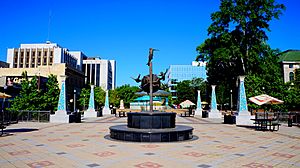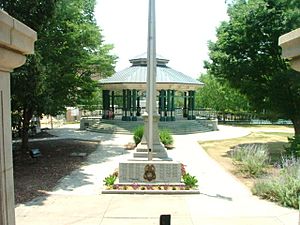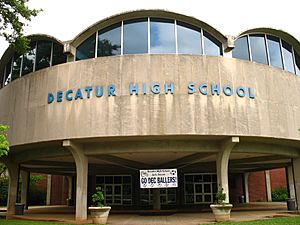Decatur, Georgia facts for kids
Quick facts for kids
Decatur, Georgia
|
||
|---|---|---|
| City of Decatur | ||
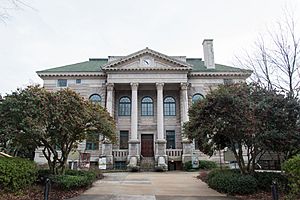
The former county courthouse
|
||
|
||
| Motto(s):
"A City of Homes, Schools and Places of Worship"
|
||
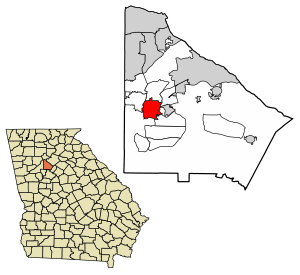
Location in DeKalb County and the state of Georgia
|
||
| Country | ||
| State | ||
| County | DeKalb | |
| Incorporated | December 10, 1823 | |
| Named for | Commodore Stephen Decatur | |
| Government | ||
| • Type | Commission–Manager | |
| Area | ||
| • Total | 4.60 sq mi (11.92 km2) | |
| • Land | 4.60 sq mi (11.91 km2) | |
| • Water | 0.01 sq mi (0.01 km2) | |
| Elevation | 1,043 ft (318 m) | |
| Population
(2020)
|
||
| • Total | 24,928 | |
| • Density | 5,422.67/sq mi (2,093.77/km2) | |
| Time zone | UTC-5 (Eastern (EST)) | |
| • Summer (DST) | UTC-4 (EDT) | |
| ZIP code(s) |
30030, 30032, 30033
|
|
| Area code(s) | 404, 678 and 470 | |
| FIPS code | 13-22052 | |
| GNIS feature ID | 0331532 | |
| Major airport | ATL | |
Decatur is a city in, and the county seat of, DeKalb County, Georgia, which is part of the Atlanta metropolitan area. With a population of 24,928 in the 2020 census, the municipality is sometimes assumed to be larger since multiple ZIP Codes in unincorporated DeKalb County bear Decatur as the address. The city is served by three MARTA rail stations (Decatur, East Lake, and Avondale). The city is located approximately 5 miles (8.0 km) northeast of Downtown Atlanta and shares its western border with both the city of Atlanta (the Kirkwood and Lake Claire neighborhoods) and unincorporated DeKalb County. The Druid Hills neighborhood is to the northwest of Decatur. The unofficial motto of Decatur used by some residents is "Everything is Greater in Decatur."
Contents
History
In 1822 Decatur was founded at the intersection of two Native American trails: the Sandtown which led east from the Chattahoochee River at Utoy Creek, and the Shallowford which follows today's Clairmont Road and eventually crossed near Roswell. The town was named for naval hero Stephen Decatur, and its early roads were named logically but soon after were renamed in a curious manner:
Shallowford Road, which led to the Shallow Ford, has been renamed Clairmont Avenue, probably because it does not go to, from or past any place called Clairmont. Covington Road is now Sycamore Street, probably because it leads to Covington and has no Sycamores on it. Nelson's Ferry Road, named after the local family which ran the ferry at the Chattahoochee end of the road, has been named Ponce de Leon after a family prominent, before Castro, in Havana, Cuba.— Stephens Mitchell, "A Tentative Reconstruction of the Decatur Town Map of 1823", Atlanta Historical Bulletin, No.30, p.8, 1965.
During the American Civil War, Decatur became a strategic site in Sherman's campaign against Atlanta. In July 1864 Union general James B. McPherson occupied Decatur to cut off the Confederates' supply line from Augusta, Georgia. During the Battle of Atlanta on July 22, Confederate cavalry under Major General Joseph Wheeler attacked McPherson's supply wagons and the Union troops left to defend the wagons. A marker at the Decatur courthouse marks the site of this skirmish.
In the last half of the twentieth century the metropolitan area of Atlanta expanded into unincorporated DeKalb County, eventually surrounding two sides of the incorporated town of Decatur. Concurrently many well-to-do and middle class white Americans fled the area to more distant suburbs. The 1960s and 1970s witnessed dramatic drops in property values. However, more recently the city has regained economic vigor, partially thanks to several long-term downtown development plans that have come to fruition, making Decatur a trendy small mixed-use district with easy transit to downtown Atlanta. Over the past twenty years, Decatur has gained a local and national reputation as a progressive city with a high level of citizen involvement that retains a small town feel despite its proximity to Atlanta.
Geography
Decatur is located at 33°46′17″N 84°17′52″W / 33.77139°N 84.29778°W (33.771355, -84.297732).
According to the United States Census Bureau, the city has a total area of 4.2 square miles (11 km2), all of it land.
The Eastern Continental Divide bisects the city along the CSX (formerly Georgia Railroad) trackage right of way.
Demographics
| Historical population | |||
|---|---|---|---|
| Census | Pop. | %± | |
| 1840 | 530 | — | |
| 1850 | 744 | 40.4% | |
| 1870 | 401 | — | |
| 1880 | 639 | 59.4% | |
| 1890 | 1,013 | 58.5% | |
| 1900 | 1,418 | 40.0% | |
| 1910 | 2,466 | 73.9% | |
| 1920 | 6,150 | 149.4% | |
| 1930 | 13,276 | 115.9% | |
| 1940 | 16,561 | 24.7% | |
| 1950 | 21,635 | 30.6% | |
| 1960 | 22,026 | 1.8% | |
| 1970 | 21,943 | −0.4% | |
| 1980 | 18,404 | −16.1% | |
| 1990 | 17,304 | −6.0% | |
| 2000 | 18,147 | 4.9% | |
| 2010 | 19,335 | 6.5% | |
| 2020 | 24,928 | 28.9% | |
| U.S. Decennial Census 2010–2020 |
|||
2020 census
| Race | Num. | Perc. |
|---|---|---|
| White (non-Hispanic) | 16,796 | 67.38% |
| Black or African American (non-Hispanic) | 3,839 | 15.4% |
| Native American | 36 | 0.14% |
| Asian | 1,317 | 5.28% |
| Pacific Islander | 12 | 0.05% |
| Other/Mixed | 1,634 | 6.55% |
| Hispanic or Latino | 1,294 | 5.19% |
As of the 2020 United States census, there were 24,928 people, 8,841 households, and 5,597 families residing in the city.
2010 census
As of the 2010 census, there were 19,335 people, 8,599 occupied housing units, and 4,215 families residing in the city. The population density was 4,603.6 people per square mile (2,860.2/km2). There were 9,335 housing units at an average density of 2,222.6 per square mile (1,380.9/km2). The racial makeup of the city was 73.5% White, 20.2% African American, 0.2% Native American, 2.9% Asian, 0.0% Pacific Islander, 0.6% from other races, and 2.4% from two or more races. Hispanic or Latino of any race were 3.2% of the population.
There were 2,541 (29.5%) households which had children under the age of 18 living with them, 3,336 (38.8%) were a husband-wife family living together, 984 (11.4%) of households had a female householder with no husband present, and 4,063 (47.2%) did not fit into either of the two previously mentioned categories. 3,263 (37.9%) of all households were made up of individuals of those, 1,814 (21.1%) had someone living alone who was 65 years of age or older. The average household size was 2.17 and the average family size was 2.96.
In the city, the population was spread out, with 25.1% under the age of 19, 5.2% from 20 to 24, 32.9% from 25 to 44, 25.7% from 45 to 64, and 11.1% who were 65 years of age or older. The median age was 38 years. There are roughly 44 males for every 56 females.
The median income for a household in the city was $73,602. Males had a median income of $73,089 versus $58,580 for females. The per capita income for the city was $42,926. About 12.20% of families and 14.9% of the population were below the poverty line, including 24.2% of those under age 18 and 12.5% of those age 65 or over.
Education levels for Decatur are above average for the Atlanta area, with 56% of residents having obtained a bachelor's degree or higher, and 27% having obtained a graduate degree or higher.
Decatur, and surrounding communities, is considered to have a lesbian presence in part due to the popularity of the Indigo Girls.
Neighborhoods and historic districts
- Adair Park
- South Candler Street-Agnes Scott College Historic District
- Chelsea Heights
- Clairemont - Great Lakes and Clairemont Historic District
- Clairemont Gateway Association
- Decatur Heights
- College Heights
- Downtown Decatur
- EverGreen Forest
- Glennwood Estates
- Lenox Place
- MAK Historic District
- Midway Woods
- Oakhurst
- Parkwood
- Ponce de Leon Heights
- Ponce de Leon Court Historic District
- Ridgeland Park
- Sycamore Street
- Westchester Hills
- Winnona Park Historic District
Festivals, special events and arts
Decatur has a thriving art and festival scene. The Decatur Arts Alliance hosts the Decatur Arts Festival each May, in addition to installing public art around the city, providing gallery space for local artists, producing YEA!, which is an event for young emerging artists, and supporting arts and arts education throughout the City.
Decatur is home to Eddie's Attic, which is a live music venue hosting shows almost every night.
Decatur is known for its frequent festivals, which include the annual Decatur Arts Festival, Decatur Stirs, Decatur Beach Party, Decatur BBQ, Blues & Bluegrass Festival, the Decatur Book Festival, the Decatur Maker Faire, The Decatur Beer Festival and the Decatur Wine Festival. Other events throughout the year include parades, Concerts on the Square, wine crawls, art walks, runs, and races.
Public art in Decatur includes Celebration (artist Gary Price), Valentine (artist George Lundeen), Thomas Jefferson (George Lundeen), Commodore Stephen Decatur (artist unknown), Roy A. Blount Plaza, and Living Walls Murals (various artists).
Points of interest
Decatur's downtown area and residential neighborhoods are filled with historic structures and sites of interest. This list primarily consists of structures on the National Register of Historic Places, but many remain privately owned and may only be viewed from the exterior.
- South Candler Street-Agnes Scott College Historic District, 141 East College Avenue. This district is on the National Register of Historic Places. It includes both the college campus and surrounding historic homes, and is book-ended by the Winnona Park Historic District to the east and the MAK Historic District to the west.
- Clairemont Historic District, north of Decatur Square
- Columbia Theological Seminary, 701 Columbia Drive. This tree-lined, brick and limestone campus lies within Decatur's Winnona Park neighborhood.
- Cora Beck Hampton Schoolhouse and House, 213 Hillyer Place. These structures are on the National Register of Historic Places.
- Decatur Cemetery, 229 Bell Street. This historic cemetery was founded in the early 19th century and is located northeast of Decatur Square.
- Decatur Railway Depot, 301 East Howard Street. Decatur's renovated depot is now a restaurant known as Kimball House.
- Old DeKalb County Courthouse, 101 East Court Square. The historic courthouse sits in Decatur Square, and contains a small history museum.
- Fraser House, Church Street and Bell Street. This modest 19th-century structure stands at the entrance to Decatur Cemetery.
- Glenwood Elementary, the oldest school in the city
- High House, North Candler Street and Sycamore Street. This antebellum structure is believed to be the oldest two-story structure in Decatur.
- Historic House Complex, 716 and 720 West Trinity Place. Three antebellum homes relocated to Adair Park.
- Historic Oakhurst, in southwest Decatur. An early 20th century town annexed by Decatur, Oakhurst still has its own business district surrounded by bungalows.
- MAK Historic District, McDonough, Adams and Kings Highway. Decatur's first local historic district is full of early 20th century American Craftsman-style homes and has been used by Hollywood for films.
- Methodist Chapel, Commerce Avenue and Sycamore Street. A beautiful granite chapel on historic Sycamore Street that is owned by Decatur First United Methodist Church.
- Old Scottish Rite Hospital, 321 West Hill Street (Oakhurst neighborhood). The historic Shriners' hospital has had an adaptive reuse and now houses restaurants and an art gallery.
- Pythagoras Masonic Lodge, 108 East Ponce de Leon Avenue. A 1924 building designed by architect William Sayward.
- Ponce de Leon Court Historic District. A single street of bungalows and palm trees east of Decatur Square (off Ponce de Leon Avenue).
- Historic Sycamore Street, Some of Decatur's largest historic residences line this street.
- Old U.S. Post Office, 141 Trinity Place. This marble-encased former federal building is on the National Register of Historic Places.
- Winnona Park Historic District, in southeast Decatur. This district is on the National Register of Historic Places for its residences and is also the home of Columbia Theological Seminary.
- Woodlands Garden, 932 Scott Boulevard. Seven acres, mostly wooded with a focus on native plants, and open to the public.
Sister cities
Decatur has three sister cities, as designated by Sister Cities International, Inc. (SCI):
 Boussé, Burkina Faso
Boussé, Burkina Faso Ouahigouya, Burkina Faso
Ouahigouya, Burkina Faso Trujillo, Peru
Trujillo, Peru
- Clarke, Caroline McKinney. The story of Decatur, 1823–1899. Dekalb Historical Society (1996).
- Gay, Mary. Life in Dixie During the War, Mercer University Press (2001).
- Kaufman, David R. Peachtree Creek: A Natural and Unnatural History of Atlanta's Watershed, University of Georgia Press (2007).
- Mason, Herman, Jr. African-American Life in DeKalb County, GA, 1823–1970 (Images of America). Arcadia Publishing (1998).
- Owens, Sue Ellen. DeKalb County In Vintage Postcards. DeKalb Historical Society/Arcadia Publishing (2001).
- Price, Vivian. Historic DeKalb County: An Illustrated History (Georgia Heritage Series). Historical Publishing Network (2007).
- Willard, Levi. Early History of Decatur.
Education
Primary and secondary schools
City Schools of Decatur, which serves only students within the city limits, holds pre-school to grade twelve, and consists of a pre-K early childhood learning center, five lower elementary schools, two upper elementary schools, a middle school, and a high school. Decatur High School is the district's sole high school. The Decatur City district has 224 full-time teachers and over 4,400 students from pre-K through grade 12.
The DeKalb County School District serves unincorporated DeKalb County.
The Roman Catholic Archdiocese of Atlanta operates St. Thomas More School in Decatur; it opened on September 1, 1950. At first it only had elementary grades and its initial enrollment was 150. A dedicated elementary building opened in 1955, and an addition for kindergarten classes with two rooms was placed in 1994. St. Peter Claver Regional School has a Decatur mailing address but is in nearby Candler-McAfee CDP.
Colleges and universities
- Agnes Scott College
- Columbia Theological Seminary
- Georgia State University's Perimeter College
- Devry University
- Emory University, northwest of Decatur, was located in unincorporated DeKalb County before being annexed by the City of Atlanta in 2017.
Public libraries
The DeKalb County Public Library system operates the Decatur Branch and is also the Dekalb County Library Headquarters.
Transportation
Major roads and expressways
 US 78
US 78 SR 155
SR 155 US 278
US 278
Mass transit
- Avondale MARTA Station
- Decatur MARTA Station
- East Lake MARTA Station
Pedestrians and cycling
- Stone Mountain Trail
Notable people
- B.o.B. - rapper, singer, songwriter, and conspiracy theorist
- James Banks III (born 1998) - basketball player
- Harrison Butker - NFL placekicker for the Kansas City Chiefs
- Jason Carter - politician
- Mark David Chapman - killed John Lennon
- Paul Delaney (born 1986) - basketball player in the Israeli National League
- Rebecca Latimer Felton - first woman Senator
- Ian Garrison - professional cyclist
- Ghetto Mafia - hip hop group
- Omari Hardwick - actor
- Keri Hilson - singer, actress
- Kiera Hogan - professional wrestler
- Jan Hooks (1957 - 2014) - actor and comedian
- Joshilyn Jackson - author
- Emily Jacobson (born 1985) - saber fencer
- Jacquees - singer, songwriter
- Alec Kann - professional soccer player
- McClain - girl group
- China Anne McClain - actress, singer
- Sierra McClain - actress, singer
- S.P. Miskowski - author
- Amy Ray (born 1964) - singer, songwriter, Indigo Girls
- Joey Rosskopf - professional cyclist
- Michael Stipe - lead vocalist, R.E.M.
- Baby Tate - rapper, singer
- Andrew Toles - outfielder for the Los Angeles Dodgers
- Rock Ya-Sin - NFL cornerback for the Indianapolis Colts
- Jordan Walker - baseball player
See also
 In Spanish: Decatur (Georgia) para niños
In Spanish: Decatur (Georgia) para niños






